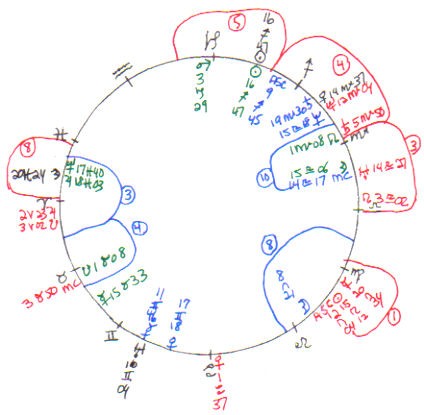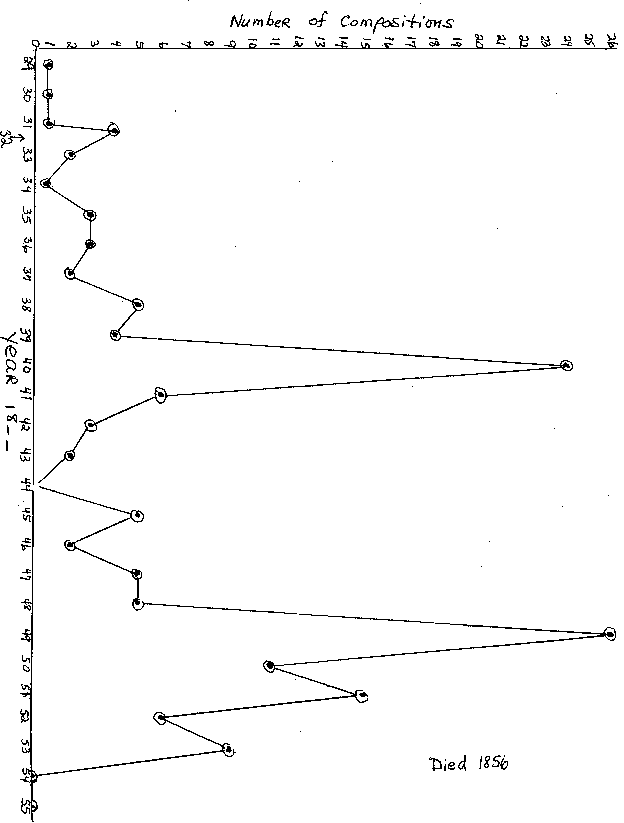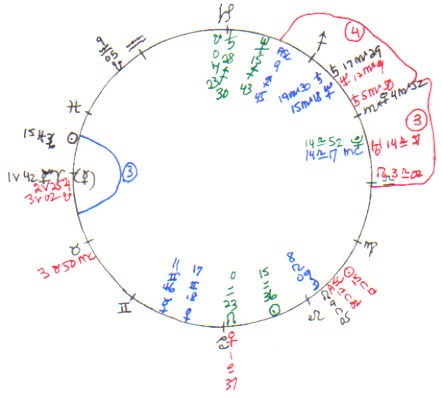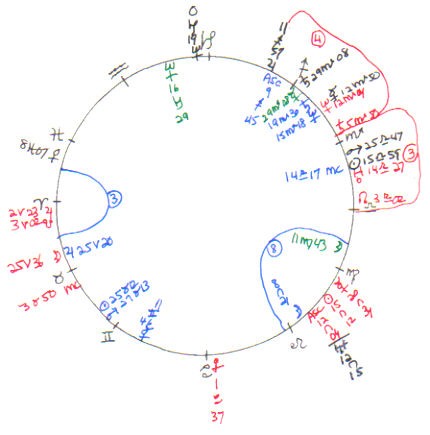

They might also want to read the paper on the depression end of this disorder. Here is the link:William Styron and Clinical Depression. And on lifelong depression Tennyson and Lifelong Depression
The Duke paper lists the astrological conditions for manic depression. The gist of it is that in bipolar disorder the planets involved are saturn (depression) and uranus (mania). The charts used for diagnosis are the 1st (early childhood and its somatic consequences) and 3rd (ordinary mentation as opposed to spiritual insights). However, an individual--as did Patty Duke--forefront (lighted and ruling an Angle and 3rd house within the chart) in other charts.
The Duke paper also contains a link, suggested by a reader, for alternative therapies, which also includes a learning center.
Several kinds of astrology "mimic" saturn or uranus. Someone with light/venus/jupiter (a golden benefic) forefront (either on an Angle or ruling an Angle) experience considerable success and emotional highs, so forefront light/venus/jupiter mimics mania. It does not, however, produce the overwhelming intensity and excess energy that uranus does.
Golden benefics work venus and jupiter being conjunction or square but not opposition. At least, when opposition they fight each other rather than cooperate for the "great good" they together can produce.
But then, if they are sharing the field with forefront mars/saturn, they produce the ups (golden benefic) and downs (mars/saturn) that mimic bipolar disorder.
Something like moon in Pisces conjunct South Node can mimic a strong saturn influence because this condition shows the moon, representing automatic consciousness conjunct the South Node, which also represent automatic consciousness. The result of the kind of consciousnes is a form of stasis, a stuckness, a lack of growth and the aridity that accompanies it. The Pisces part of it makes it worse because it takes the individual into neptunian--vague, hard-to-define-or-see, illusory--states that he hardly even realizes he has slipped into.
In his book, The Secret Life of the Brain, Richard Restak, M.D., includes a bar graph illustrating Schumann’s musical production during the years 1829, when he was 19 years old, to his death in 1856. Within that time period Schumann made two suicide attempts (here considered depressed years), suffered a year of severe depression, and two separate years of mania. A majority of his compositions were written during those two separate years of mania.
This paper illustrates that each suicide attempt as well as major episode of depression correlated with forefront saturn in Schumann’s charts. His major manias occurred when he had either additional (in addition to his already manic chart) forefront uranus, or else forefront benefics.
It also shows the major signature set for composers.
Below is a partial 7th chart showing Schumann as most individual’s recognize his identity.
For a full explanation of the astrology used on this site, go to “About This System” listed among other papers on the Home Page. For those who do not want to do that, there is this note: this system uses only conjunctions, applying and separating squares, and oppositions. Orbs with lights is 5°; without lights, about 2.5°.
Birth planets (including their harmonics) rule only birth houses. Conception planets (including their harmonics) rule only conception houses. In the partial charts below, birth planets are shown in blue, birth harmonic planets in green--both inside the circle, and conception planets are shown in red while conception harmonics are shown in black--both outside the circule. Returning to Schumann:

The set involving c sun, c7 venus, and b neptune is the one I look for with composers. C sun rules C Asc in b 3rd house. C7 venus rules C MC and co-rules c 3rd house (30 of 34°). B neptune rules b 3rd house. This shows multiple influence to 3rds, and one influence to an Angle of sun/venus/neptune. Venus represents harmony and beauty, and neptune longing. Sun in Leo is naturally creative. Their combination impels Schumann to express (sun) the inexpressible (neptune). Mercury is also part of this set and likely helped with the written component of Schumann’s composing.
C venus, his other, non-harmonic ruler of C MC and c 3rd house, is in a set with node and jupiter. He is naturally high, lucky, and optimistic.
B MC is conjunct moon and uranus, and is in c 3rd house. He is an innovator (uranus in the 3rd house). The set involving b venus, ruler of B MC in c 3rd house, adds a third b>sun/venus/jupiter/neptune influence to Schumann’s c 3rd house, giving him an enormous desire to express himself (3rd) creatively. That last venus, in Gemini, also favors writing. B7 jupiter conjunct neptune is in b 3rd house, and shows a need, longing, and ability to expand (jupiter) mentally (3rd house) through imaginary and creative (neptune) endeavors. In fact, jupiter and neptune in Pisces are conjunct c7 moon in Pisces--all in b 3rd. He has psychic abilities and sensitivities (Pisces moon in 3rd house in 7th chart). The 8th house part of that 3rd/8th overlap must make him extraordinarily sensitive to the feelings of others. It also gives him and a sense of merging with them. In good times that is good. In bad times, he is unable to separate his own identity from that of close others. That becomes more important when we consider his non-harmonic saturns.
Schumann’s c saturn, in Scorpio, opposition his C MC (2°) looks like the major indicator of his depression. Certainly it counts, but it is progressing direct, therefore moving away from his C MC. He has a more life-threatening problem with his b saturn. It is also in Scorpio, in a wide square to his c sun (ruling Asc) conjunct his C Asc. It is more life-threatening because it is progressing toward both.
B7 south node in Taurus conjunct his C MC is a bit of a hint that Schumann is a sensualist.
Below, from Restak's book, is the bar graph converted to a line graph. It shows Schumann’s musical production during the years 1829 until his death in 1856. Reader’s interested in which compositions he wrote during these years should consult Restak’s book, cited below. (Sorry, I have to put this in turned on its side.)

In spite of the use of “hypo-” (Restak’s choice of word) which usually means lowered or less, these are understood to be manic periods.
The paper on Patty Duke identifies manic depression as located primarily in the 1st and 3rd charts. Schumann’s 1st chart is not horribly afflicted, but it does show a split in influences to his 3rd houses.

B 3rd house has picked up a saturn influence (b sun/ c1 saturn/ b neptune, ruler of b 3rd). C 3rd house has also picked up a saturn influence (C MC/ c saturn/ c1 venus, ruler of C MC and c 3rd house). C venus--discussed above as node/venus/jupiter in his 7th chart--has also picked up a saturn influence. So, the sets in his 7th chart, which show his desire to express himself to others as a creative, thereby contributing individual, are the same sets that are “squelched” (saturn) in his 1st chart. Mercury is also a part of this last set, and is perhaps an index of some kind of brain function (see Footnote 1, below). Mercury/neptune in this chart appears to indicate right-brainedness (neptune--whole-making). Mercury/saturn, in this chart, probably retards (saturn) brain function. Schumann’s b moon conjunct jupiter (ruler of B Asc) opposition c1 mars brings a forefront mars influence into his c 3rd (because mars is in the 3rd.).
All together, then, Schumann does have saturn influence to Angles and both 3rd houses, and mars influence only to c 3rd. Mars and saturn represent dissonance.
B MC conjunct b uranus (in c 3rd house) has again picked up a light, this time b1 sun at 15 Cancer 36, squaring it.
The 3rd chart is usually the first place we look for indications of manic depression. At least one Angle and one 3rd house should be influenced by saturn and uranus. If they are in separate sets their contrast is even more powerful than if in the same set. So, on to the 3rd chart.

Schumann’s 3rd chart shows him to be far more manic than he is depressive. C Asc has acquired a conjunction of c3 uranus at 12 Leo 15. Note that c3 mercury at 12 Scorpio 50 and ruling c 3rd house, is also a part of this set. It decreases the slight tendency to psychosis this set represents (it plays out in writing), but it also connects it to the second 3rd house (giving him lighted neptune influence to both 3rd houses. However, none of these are harmonic, which is required, except mercury). B MC, conjunct non-harmonic uranus, has--as it did in his 7th chart--acquired a light, but this time it is c5 sun at 15 Libra 59. It has also acquired b5 neptune, at 16 Capricorn 29, ruler of b 3rd house. So this last set is influencing both 3rd houses. His node/venus/jupiter has acquired neptune, giving this set Angular and 3rd influence through venus. These are not depressive. They tend toward mania (uranus), creativity (neptune), and psychosis (neptune).
Where is the saturn influence?
C mercury, ruler of c 3rd house, is square b saturn, but it has no Angular influence. B5 saturn is opposition b moon, but neither rules an Angle or a 3rd. B mercury (this is the 3rd chart,so mercury aspects have more influence even when not technically forefront because mercury is naturally associated with the 3rd house) is conjunct saturn and opposing sun conjunct mars. This is his most important 3rd chart saturn condition. None of these sets rules an Angle or a 3rd house.
Although none of Schumann’s 3rd chart saturns are strong enough to immediately qualify this chart for depressive, they do, it turns out, contribute, as is shown below. His main problem with saturn occurs because of its position, sign, and timing. Timing: as shown below, his suicide attempts and depression occur when he has progressed Angle to saturn. Sign: his two non-harmonic saturns are in Scorpio, with 8th house implications. When under their influence (one is square mercury, ruler of c 3rd house), he is emotionally alienated. He either feels nothing (saturn) or loss of connection (Scorpio). These are hardly good for composing. His c sun is in Leo conjunct his C Asc in his b 8th house. With that he feels vitally (sun) connected (8th) and expressive, creative (Leo) with others. His 8th influences, therefore, show him on an extreme emotional see-saw. Position: both of Schumann’s non-harmonic saturns are in c 4th house. Every time an Angle progressed to one or the other or their progressed positions, he either believed he was dying (4th house), or wished he was. As it turned out, Restak’s book claims he died of self-starvation, so I guess he wished he was and was successful at it.
Schumann’s first longer-term (that is, more than a lunar progression) experience of one of his 4th house saturns in Scorpio occurred (the exact opposition) on September 20, 1813, when Schumann was a little over 15 months old. It represented his first experience of disconnection and lasted 9 months to a year. Since it occurred before he had hardly any self-identity, his response was primitive. Every time it recurred his response would be equally primitive. Too bad we do not really know what was happening in his life at the time. Such information may be in his biography, but probably is not. The long-term emotional devastations of our formative years are not usually covered in biographies. Schumann’s first experience of this same saturn as a 3rd chart saturn was from May 6, 1813 to around October 4, 1813, when he was three to three-and-one-half years old. During that time his progressed c3 sun moved from 3 Scorpio 50 to 5 Scorpio 50, and was highlighting his 2° C MC opposition saturn in Scorpio. Only direct and keen observation could establish what occurs in the mind of children that young.
In fact, Schumann’s sun conjunct Asc in Leo shows he was given special attention in childhood. His 4th (home environment) saturns in Scorpio indicate devastating abandonment. This is what is really meant by the word “spoiled.” He was alternately given too much (precious) and too little (nothing) attention, leaving him bewildered. His character, then being formed, was deformed for the remainder of his life.
Because the majority of his episodes of mania and depression showed progressed Angles to non-harmonic saturn and uranus, respectively, progressions shown below are for his 3rd chart only. Usually both 3rd and 1st chart need to be looked at.

A reminder: only the year, and not the date, was given for each episode. So, progressions are for July 1--rough midpoint--of each. Only the major sets are shown.
1833, Suicide Attempt
| B MC | 6 Scorpio 18 |
| c saturn | 5 Scorpio 50 |
| pC MC | 27 Taurus 04 |
| b mars | 27 Taurus 03 |
| pC Asc | 29 Leo 31 |
| b3 mercury | 28 Scorpio 49 |
| c3 saturn | 29 Scorpio 08 |
1840, Hypomanic
| pB MC | 12 Scorpio 53 |
| C Asc | 12 Leo 04 |
| c3 uranus | 12 Leo 15 |
| c neptune | 12 Scorpio 04 |
| c3 mercury | 12 Scorpio 50 |
| pB Asc | 14 Capricorn 08 |
| B MC | 14 Libra 17 |
| c uranus | 14 Libra 27 |
| pC MC | 3 Gemini 57 |
| b3 uranus | 3 Virgo 50 |
1844, Depressed
| pB MC | 16 Scorpio 47 |
| pb saturn | 17 Scorpio 21 |
| pc saturn | 8 Scorpio 17 |
| b moon | 8 Leo 21 |
Progressing b saturn is approaching the exact square to his b moon. Even though it does not have Angular or 3rd influence, it does give him another lighted saturn in Scorpio in c 4th house. In the manic episode of 1849, it has moved on to 8 Scorpio 44 and its influence is waning.
| pc3 saturn | 11 Sagittarius 23 |
| c3 jupiter | 11 Sagittarius 57 |
| b mercury | 11 Gemini 46 |
| b3 moon | 11 Virgo 43 |
| c3 venus | 8 Pisces 07 |
Progressed harmonic saturn has come upon one of his happy, creative sets. Venus here rules c 3rd house and C MC.
1849, Hypomanic
| pB MC | 12 Gemini 50 |
| pB Asc | 11 Virgo 44 |
These Angles pick up--at least--his moon/mercury/jupiter just above. Progressed c3 saturn has moved away and is at 13 Sagittarius 42. He has no uranian influence in this year. He has Angles to a benefic (something earlier noted as mimicking mania), which, with his original manic proclivities, resulted in his great creativity.
1856, Death, Self-Starvation
I have never seen death indicated in the 3rd chart, so we have to go to conditions in the 1st chart.
| pB MC | 28 Scorpio 19 | |
| pc3 saturn | 28 Scorpio 19 | in c 4th house |
| pc3 mars | 4 Aquarius 29 | ruler of c 4th house |
| C MC | 3 Taurus 50 |
| pB Asc | 14 Aquarius 19 | |
| pb neptune | 14 Scorpio 20 | ruler of b 3rd house |
He has Angular influence of mars, saturn, and neptune. These are siege conditions. Whether or not neptune’s influence to a 3rd house makes a difference is not known, but since he starved himself to death, it was included.
An all-charts slow secondary progression which probably played a part in Schumann’s decline was:
| pb saturn | 16 Scorpio 52 R |
| c sun | 15 Leo 12 |
| C Asc | 12 Leo 04 |
C sun rules C Asc and is slowly being approached by progressing saturn. It is still too far from his Asc, but sun, as ruler, would especially increase orb. It is difficult to know how much.
My data source stated Schumann was syphilitic. Certainly his 1st chart on the date of his death could represent the siege conditions of late stage syphilis. He may have starved himself to save himself the misery of end-stage syphilis.
Schumann charts are not entirely typical of earlier charts on bipolar disorder. Schumann’s 3rd chart is short on forefront saturn influence. Forefront uranus is there--powerfully there. Notwithstanding his low pre-progressed saturn influence, his major manic and depressive episodes occurred under forefront influence of uranus and saturn, respectively.
It is difficult enough to have saturn in the 4th house because it represents early feeling (Cancer/4th) deprivation (saturn). The 4th house shows, somewhat, both our cradle and our grave. Even though information in the 4th chart is usually associated with the father, the 4th house also contains information about our early nurturing (Cancer). Schumann has saturn in Scorpio in his 4th. That sign brings in the deprivation (saturn) of the 8th house (Scorpio--our sense of meaningful and productive belonging). Having been “spoiled” as a child, he was ill-equipped to handle his progressed Angles to saturn. They are always difficult, but Schumann’s conviction he should always be the center of attention (Sun conjunct Asc in Leo) left him bereft of psychological equipment necessary to handle the times--which we all experience--when he could not be.

Footnotes
(1) It would be nice to know more about exactly what these two charts--1st and 3rd--represent, and what their interaction implies. So far meanings for all the charts have been derived from research, guesses based on astrological principles, and observations, necessarily
limited.
Data Acknowledgments
Robert Schumann
Birth: 6/8/1810, 9:10 p.m. LMT, Zwickau, Germany. From Astrodatabank
by Lois Rodden and Mark McDonough. Information from the American Federation of Astrologers, “confirmed by
parish records. Also: Joan Chisel’s biography, Schumann, page 13.
Conception:8/31/1809, 4:58:41 a.m. LMT, Zwickau, Germany.
This was listed as DD data, that is, “dirty (possibly incorrect) data.” Considering it was taken from parish records and confirmed by a second source, it has at least a chance of being close to correct.
Contact the author at: sleeweidner@yahoo.com